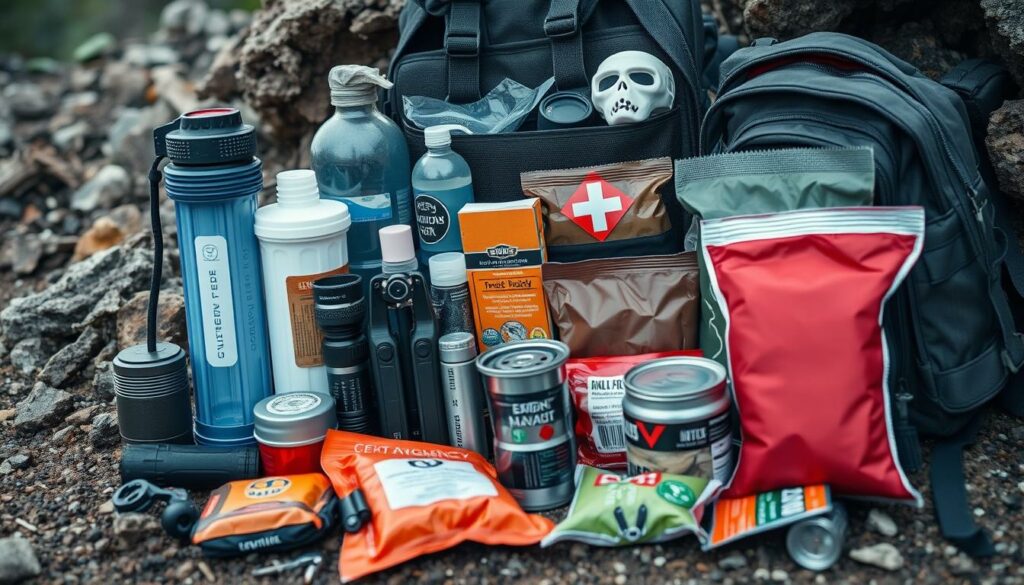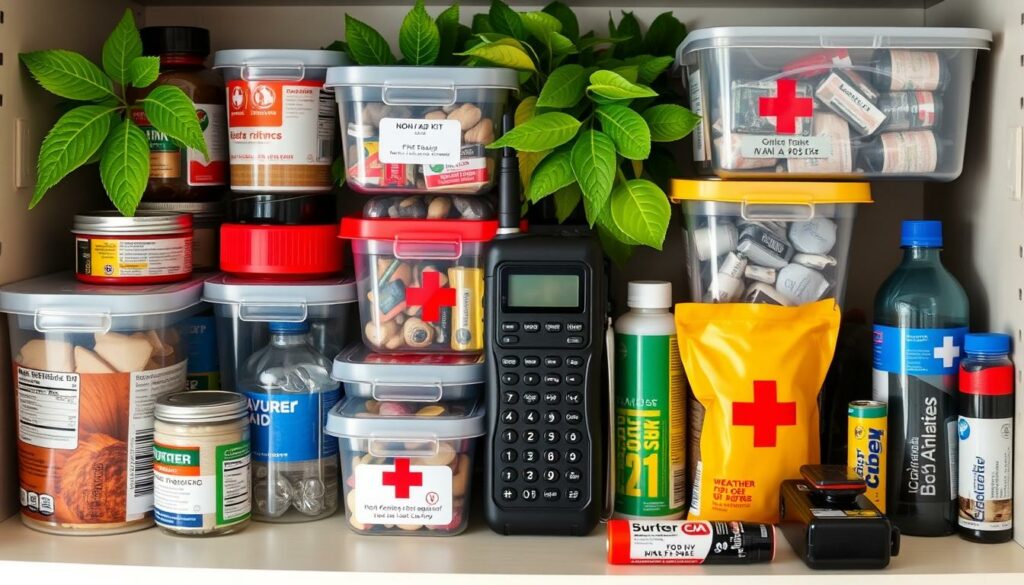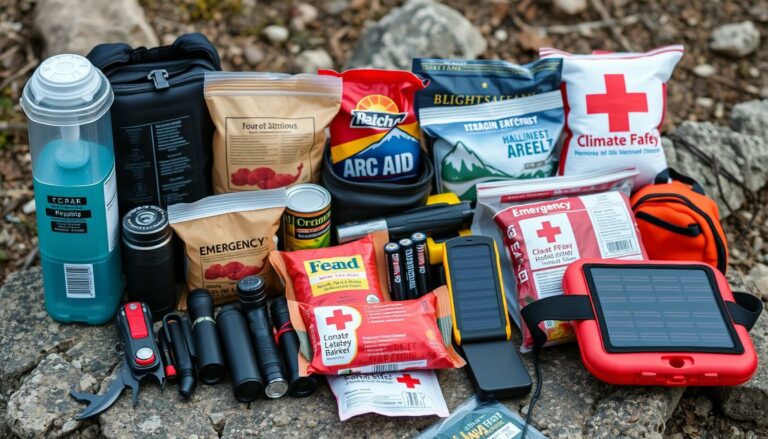Climate change has made extreme weather events more common and severe. It’s vital to be ready for these challenges. A climate-ready emergency kit is your key to survival during disasters, offering essential supplies.
This guide will help you create a kit for any climate scenario. Whether you face droughts, floods, or hurricanes, a well-stocked kit can be a lifesaver. FEMA suggests having supplies for at least 72 hours. This includes one gallon of water per person per day and three days of non-perishable food.
Your kit should be ready for different climate challenges. For heat waves, add cooling towels and electrolyte solutions. For floods, use waterproof containers. For hurricanes, include tarps and battery-powered radios.
Remember, a climate-ready emergency kit is not just for survival. It’s about staying comfortable and safe in unpredictable times.
Key Takeaways
- A climate-ready emergency kit should contain supplies for at least 72 hours
- Include one gallon of water per person per day for drinking and sanitation
- Pack a three-day supply of non-perishable food items
- Add climate-specific items based on your region’s weather patterns
- Include a battery-powered radio and extra batteries for communication
- Don’t forget personal hygiene items and a first aid kit
- Regularly check and replace expired items in your kit
Understanding Climate-Ready Emergency Kits
Climate-ready emergency kits are key for today’s survival. They pack resilient supplies to help families through climate emergencies. With more extreme weather, the right gear is vital.
What is a Climate-Ready Emergency Kit?
A climate-ready kit is a set of tools and supplies for various weather conditions. It has water, non-perishable food, first-aid, and ways to communicate. It aims to keep a family safe for at least three days.
Why Are These Kits Essential Today?
These kits are more necessary than ever. The U.S. sees about 10 weather disasters a year, causing huge damage. A survey shows most people are not well-prepared.
- Water needs can double in hot temperatures
- Four liters of water per person per day is recommended
- Non-perishable food supply should last 3-7 days
- Include cash, seasonal clothing, and important documents
Preparing a climate-ready kit with the right supplies boosts family confidence. These kits ensure safety and support green emergency prep.
Types of Natural Disasters to Prepare For
Climate change has made natural disasters more common and intense. It’s key for every home to have a sustainable emergency kit. Let’s look at the main disasters you should prepare for.
Droughts and Extreme Heat
Dry spells and hot temperatures can be deadly. Your kit should have at least one gallon of water per person per day for three days. Choose foods that need little water to make.
Consider adding a LifeStraw Personal Water Filter ($19.95) to your kit. It ensures safe drinking water in emergencies.
Floods and Flash Flooding
Water surges can destroy communities quickly. Make a home escape plan with two routes from each room and a meeting point. Include waterproof containers for important documents.
Store non-perishable food like the Wise Company Emergency Food Supply ($111.59). It can last up to 25 years.
Hurricanes and Severe Storms
These storms can cause a lot of damage and power outages. Your kit should have items like Amerelle Power Failure Lights ($29.99) and a small first aid kit ($49.99). Pack warm blankets and layers for winter storms.
A two-week food supply is good for long emergencies. A well-prepared kit is crucial when disaster hits. Keep your supplies updated to face nature’s challenges.
Essential Items for Your Emergency Kit
It’s key to have a good crisis readiness pack today. Events like Hurricane Ida and wildfires show why we need to be ready. Your kit should have things to keep you and your family safe for days.
Water and Hydration Solutions
Keep one gallon of water per person per day. For a family of four, that’s 28 gallons for a week. Think about water purification tablets or filters too.
Non-Perishable Food Supplies
Stock up on food that lasts for days. Pick items that don’t need to be refrigerated or cooked. Don’t forget a manual can opener and pet food if you have pets.
First Aid and Emergency Medical Needs
A good first aid kit is essential. Include prescription meds, glasses, and other medical needs. Also, have dust masks to clean the air.
Tools and Communication Devices
Your emergency stockpile should have:
- Flashlight with extra batteries
- Battery-powered or hand-crank radio
- Whistle to signal for help
- Wrench or pliers to turn off utilities
- Local maps for navigation
- Cell phone with chargers and backup battery
Keep your kit updated by replacing old items and checking it every year. With these items, you’ll be ready for emergencies.
Specific Gear for Extreme Weather Scenarios
A climate-ready emergency kit needs gear for different extreme weather. Let’s look at key items for each scenario. This way, you’ll be ready for any climate challenge.
Heat-Resistant Gear for Droughts
For hot temperatures, your kit should have:
- Lightweight, breathable clothing
- Wide-brimmed hats
- Sunscreen (SPF 30+)
- Cooling towels
- Portable battery-operated fans
Waterproof Gear for Flood Situations
For flood preparedness, include these essentials:
- Waterproof containers for documents
- Rubber boots
- Inflatable raft or life jackets
- Water purification tablets
- Waterproof flashlights
Windproof and Insulated Supplies for Hurricanes
To face severe storms, your kit should have:
- Windproof tarps
- Battery-powered or hand-crank radio
- Non-electric can opener
- Warm blankets
- Waterproof and windproof jacket
| Weather Scenario | Key Items | Quantity per Person |
|---|---|---|
| Drought | Water | 1 gallon per day |
| Flood | Waterproof Boots | 1 pair |
| Hurricane | Nonperishable Food | 3-day supply |
Adjust your kit for your area’s most likely weather. But keep it versatile for surprises. Update your supplies every six months to stay ready for any extreme weather.
Customizing Your Kit for Family Needs
Creating a personalized disaster preparedness kit is key to keeping your family safe. It’s important to tailor your supplies to fit your family’s specific needs. This ensures you’re ready for any crisis.
Considerations for Infants and Small Children
When preparing for little ones, remember to pack essentials like formula, bottles, and diapers. Comfort objects can also help ease their stress. Make sure to update these kits every 2-3 months. Aim for a 5-day supply of disposables.
Preparing for Pets in Emergencies
Don’t forget about your furry friends! Pet disaster kits should include:
- 5-day supply of food and water
- Portable kennel
- Leash and collar
- Vaccination records
Special Needs Accommodations
For family members with unique needs, remember to pack:
- Adequate medication supply
- Assistive devices
- Necessary medical equipment
Don’t forget to consider dietary restrictions and personal hygiene needs. Store your kit in a portable container near exits. Check it twice yearly to replace expired items. Tailoring your emergency supplies makes your family more resilient against disasters.
“A well-prepared family is a resilient family. Customize your emergency kit to protect what matters most.”
Planning for Longer Emergencies
When disaster hits, being ready for a long time is key. You need the right survival gear and eco-friendly supplies. Let’s look at how to get ready for long emergencies.
When to Expect Shelter-in-Place Situations
Shelter-in-place orders can last days or weeks. It’s smart to prepare for at least three days at home. Stock up on water and non-perishable food. The CDC says you need one gallon of water per person per day, more for kids, nursing moms, and the sick.

Building a Supply of Essential Medicines
Your emergency kit should have a week’s worth of medicines. Don’t forget over-the-counter items like pain relievers and antacids. For those with prescriptions, keep an extra supply. Also, include contact lens solution and eyeglasses.
Creating a Communication Strategy
Staying connected in emergencies is crucial. Make a family communication plan with emergency contacts and meeting spots. Here are some tips:
- Keep a battery-powered or hand-crank radio for news updates
- Store important documents in a waterproof container or digital format
- Have cash or traveler’s checks for emergencies
- Include activities for children to maintain a sense of normalcy
Your survival gear should be easy to carry. A camping backpack or duffle bag is perfect for your supplies. Stay prepared, stay safe.
Storage Solutions for Your Emergency Kit
Storing your emergency kit right is key for adapting to climate changes. Let’s look at smart ways to keep your supplies ready for any disaster.
Best Practices for Kit Organization
Use clear, airtight containers for your emergency kit. This keeps your supplies safe from moisture and pests. It also makes it easy to find what you need.
Put similar items together, like food, water, and medical supplies. Label each container well so you can find things fast when it matters most.
Choosing the Right Containers
Pick containers that are tough and easy to carry. Plastic bins or backpacks work great. If you live in a hurricane zone, choose waterproof ones.
Your containers should be simple to carry if you need to leave quickly.
Where to Store Your Kit
Put your emergency kit in a cool, dry spot that’s easy to get to. Avoid places that might flood or get too hot. Have a smaller kit in your car for extra safety.
Make sure everyone in your family knows where these kits are.
- Store enough supplies for at least three days
- Include two gallons of water per person per day
- Rotate food and water every six months
- Review and update your kit annually
By following these tips, your emergency kit will always be ready. Stay prepared and stay safe!
Regular Maintenance and Updates
It’s key to keep your crisis readiness pack in good condition. Your emergency stockpile needs regular checks to be ready for emergencies. Let’s explore how to keep your kit in top shape.
Check Your Kit Regularly
Make a plan to check your emergency supplies twice a year. Many people check their kits when daylight saving time changes. This keeps your kit updated and ready for emergencies.
Spotting Items That Need Replacement
Watch for signs that items in your kit need to be replaced:
- Expired food or medications
- Leaking batteries
- Damaged or worn-out clothing
- Outdated documents or contact information

Managing Expiration Dates
Make a simple plan to track expiration dates in your emergency stockpile. Use a spreadsheet or notebook to list items and their expiry dates. Set reminders on your phone or calendar to remind you when to replace perishables.
| Item | Shelf Life | Replacement Frequency |
|---|---|---|
| Bottled Water | 1-2 years | Annually |
| Canned Food | 2-5 years | Every 2 years |
| Batteries | 5-10 years | Every 5 years |
Remember, a well-maintained crisis readiness pack is crucial in emergencies. By following these steps, you’ll make sure your kit is always ready to support you and your family.
Community Resources and Support
Creating a climate-ready emergency kit is key for disaster preparedness. But, it’s not something you should do alone. Your community has many resources to help you get ready.
Local Emergency Planning Agencies
Reach out to your local emergency management office. They can give you advice on making a kit for your area. These offices often have free workshops and materials to help your community get ready.
Online Resources and Information Networks
Websites like Ready.gov and FEMA have lots of tips for getting ready for disasters. They cover how to make your emergency kit and plan for your family. The American Red Cross also has great resources, like a Family Readiness Toolkit.
Neighbor-to-Neighbor Support and Kit Shares
Think about starting a neighborhood group for preparedness. You can share resources, knowledge, and even make community kits together. This not only saves money but also builds stronger community ties.
| Item | Recommended Amount | Notes |
|---|---|---|
| Water | 1 gallon per person per day | 3-day supply minimum |
| Non-perishable food | 3-day supply | Replace annually |
| Prescription medications | 2-week supply | If possible |
| Emergency plan review | Annually | 20 minutes to create |
A well-prepared community is stronger against disasters. By using these resources, you’ll be more ready for any climate emergency.
Building Awareness and Preparedness
Starting a culture of readiness at home is key. Families who talk and practice emergency plans are 75% more likely to act fast in crises. It’s vital to teach family members about essential supplies and how to stay safe.
Educating Family Members
Regular talks about emergency plans are essential. Families that practice evacuation twice a year respond 50% quicker in real emergencies. Don’t forget to include pets in your plans, as families with pet strategies are 40% more likely to take their pets with them.
Importance of Community Workshops
Community workshops are crucial for spreading the word. Emergency Preparedness Week, held since 1996, helps communities teach about essential supplies and weather safety. These events often feature:
- Interactive demos of emergency kits
- Evacuation drills
- Info on local hazards
Engaging with Local Emergency Services
Working with local emergency services boosts community readiness. In disaster-prone areas, prepared homes are 60% more likely to evacuate on time with the right supplies. Talk to local services to learn about regional risks and response plans.
| Preparedness Action | Impact |
|---|---|
| Family Emergency Plan | 75% more effective crisis response |
| Bi-annual Evacuation Practice | 50% faster evacuation time |
| Pet-Inclusive Planning | 40% higher pet evacuation rate |
Conclusion: Stay Prepared for Any Climate Challenge
Being ready for climate emergencies is key in today’s world. Only 39% of families have an emergency plan. This leaves many at risk during unexpected disasters. Creating a climate-ready emergency kit is a big step towards safety.
The Importance of Being Proactive
It’s not just about having supplies. It’s about being ready. Families with kits are 60% more likely to stay safe. Regular practice of plans can boost evacuation rates by 50%.
Encouraging Others to Take Action
Share the need for climate-ready kits. Help others build kits with eco-friendly items. Remember, local responders might not reach everyone right away. A 72-hour kit with water, food, and hygiene items can be crucial.
By working together, we can make our communities more resilient. Let’s stay informed and proactive against climate emergencies.
FAQ
What is a climate-ready emergency kit?
A climate-ready emergency kit is a set of essential supplies. It helps people and families survive climate-related emergencies. It includes water, non-perishable food, first aid, and tools for several days when services are disrupted.
Why are climate-ready emergency kits important?
These kits are key because of more frequent and severe weather events. They offer vital resources for survival during disasters. This ensures you have what you need when services are not available.
What types of natural disasters should I prepare for?
You should prepare for many disasters, like droughts, floods, and hurricanes. Each disaster needs specific preparations and supplies.
What are the essential items for a climate-ready emergency kit?
Key items include water, non-perishable food, and a battery-powered radio. Also, a flashlight, first aid kit, and extra batteries are important. Don’t forget a whistle, dust mask, and plastic sheeting.
Include a wrench, manual can opener, and local maps. And, have a cell phone with chargers and a backup battery.
How should I customize my emergency kit for my family’s needs?
Make your kit fit your family’s needs. For babies, add formula, bottles, and diapers. For pets, include food, water, and vaccination records.
Think about special needs, medications, and personal hygiene items for everyone.
How often should I check and update my emergency kit?
Check your kit twice a year, like when daylight saving time changes. Replace expired food, medications, and batteries. Update clothing and keep an inventory with reminders.
Where should I store my climate-ready emergency kit?
Keep your kit in a cool, dry place that’s easy to reach. Use clear, airtight containers. Have kits at home, work, and in your vehicle. Make sure everyone knows where they are.
How can I involve my community in emergency preparedness?
Work with local emergency planning agencies and join community workshops. Create support systems with your neighbors. Consider sharing kits to pool resources.
Encourage schools and workplaces to have emergency plans.
What specific gear do I need for extreme weather scenarios?
For droughts and heat, include heat-resistant clothes and sunscreen. For floods, have waterproof containers and rubber boots. Hurricanes need windproof tarps and non-electric can openers.
Adjust your kit for the most likely disasters in your area.
How can I stay informed about potential climate-related emergencies?
Stay in touch with local emergency services and use online resources like Ready.gov. Consider a battery-powered or hand-crank radio. Have a plan for communication with your family, including backup methods.
Source Links
- https://www.ready.gov/kit
- https://www.fema.gov/press-release/20210318/how-build-kit-emergencies
- https://www.wunderground.com/prepare/disaster-supply-kit
- https://www.cooldavis.org/2024/01/03/chat-with-the-chief-are-you-ready/
- https://www2.gov.bc.ca/gov/content/safety/emergency-management/preparedbc/build-an-emergency-kit-and-grab-and-go-bag
- https://extension.oregonstate.edu/catalog/pub/em-9337-survival-basics-emergency-kits
- https://ors.od.nih.gov/ser/dem/emergencyPrep/Pages/Disaster-Preparedness-Tips.aspx
- https://www.fcs.uga.edu/extension/preparing-an-emergency-food-supply-short-term-food-storage
- https://www.safewise.com/emergency-kits/
- https://www.fema.gov/blog/10-items-include-your-emergency-kit
- https://dem.nv.gov/preparedness/Emergency_Preparedness_Checklist/
- https://www.weather.gov/owlie/emergencysupplieskit
- https://10best.usatoday.com/interests/home-garden/go-bag-essentials-emergency-kits/
- https://www.orangecountync.gov/3471/Build-a-Kit
- https://beready.utah.gov/family-preparedness/get-a-kit-family/
- https://prepareky.com/resources/family-emergency-kit/
- https://www.cdph.ca.gov/Programs/EPO/Pages/PrepareanEmergencySupplyKit.aspx
- https://ready.illinois.gov/plan/emergencykit.html
- https://www.gominis.com/blog/2024/may/emergency-storage-solutions-for-hurricane-disast/
- https://www.scemd.org/prepare/your-emergency-plan/family-disaster-plan/family-emergency-kit/
- https://www.greenandprosperous.com/blog/essential-guide-to-building-emergency-preparedness-kits-for-natural-disasters
- https://www.nyc.gov/site/em/ready/get-prepared.page
- https://www.healthychildren.org/English/safety-prevention/at-home/Pages/Family-Disaster-Supplies-List.aspx
- https://www.getprepared.gc.ca/cnt/rsrcs/pblctns/yprprdnssgd/index-en.aspx
- https://ioem.idaho.gov/building-an-emergency-kit/
- https://www.redcross.org/get-help/how-to-prepare-for-emergencies/make-a-plan.html?srsltid=AfmBOooIJabq6hbuh3SBQxeviWCX9RViO0I44mfq9SjD5zJrMpP-544g
- https://www.getprepared.gc.ca/cnt/rsrcs/ep-wk/tlkt-en.aspx
- https://www.phila.gov/2023-04-13-a-step-towards-preparedness-what-to-have-in-your-home-emergency-kit/
- https://www.habitat.org/our-work/disaster-response/disaster-preparedness-homeowners/family-preparedness-plan
- https://sheriff.deschutes.org/divisions/special-services/emergency-management/before-a-disaster-emergency-preparedness/

